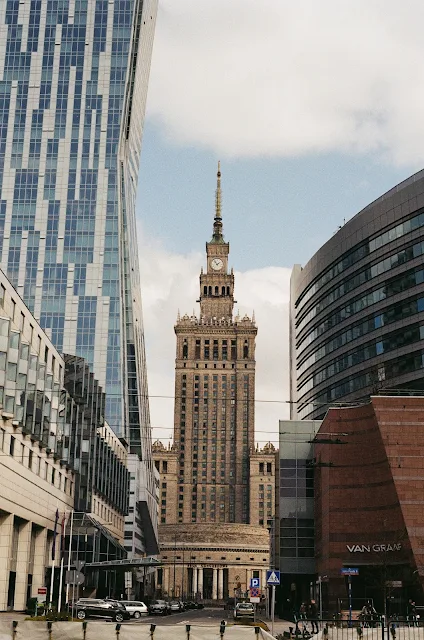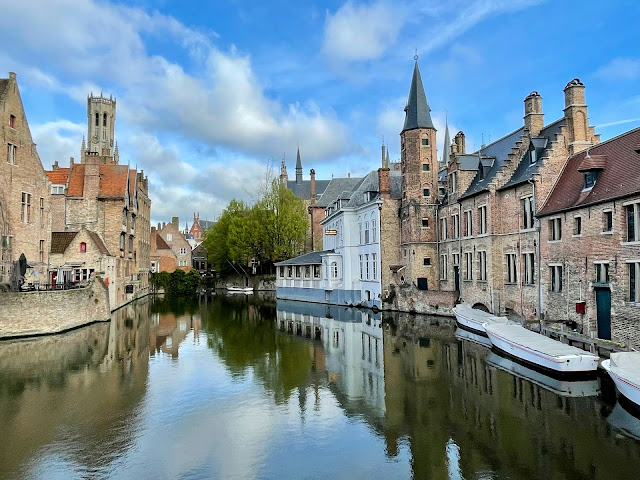Exploring Warsaw's Rich Heritage: A Journey Through History and Resilience
If you are looking for a city that combines history, culture and cuisine, Warsaw is a great choice. Warsaw is the capital of Poland and one of the most resilient cities in Europe. It survived the devastation of World War II and the oppression of communism, and emerged as a vibrant and modern metropolis. In this blog post, I will share with you some of the best places to visit in Warsaw and things to do during your stay.
One of the highlights of Warsaw is the Royal Way, a historic route that connects the royal residences and monuments of the city. The Royal Way starts at the Palm Tree, a quirky art installation that symbolizes Warsaw's cosmopolitan character. From there, you can walk along Nowy Swiat, a lively street with shops, cafes, and restaurants. You can stop by A. Blikle, a famous pastry shop that dates back to 1869, and try their delicious donuts filled with rose jam. Or you can visit Bar Mleczny Familijny, a traditional milk bar that serves cheap and hearty Polish dishes.
As you continue along the Royal Way, you will reach Copernicus Square, where you can admire a statue of the famous astronomer who was born in Poland. You can also visit the Holy Cross Church, where Chopin's heart is buried in a pillar. The Royal Way then changes its name to Krakowskie Przedmiescie, and becomes more elegant and colorful. You will pass by several palaces, churches, and museums, such as the Presidential Palace, the University of Warsaw, and the National Museum.
The Royal Way ends at the Castle Square, where you can see the impressive Royal Castle, the former residence of the Polish kings. The castle was completely destroyed during World War II and rebuilt in the 1970s using old paintings and photographs. You can enter the castle and admire its richly decorated rooms, such as the Throne Room, the Great Assembly Hall, and the King's Apartment.
From the Castle Square, you can explore the Old Town, one of the most charming areas of Warsaw. The Old Town was also reconstructed after World War II and is now a UNESCO World Heritage Site. You can stroll along the cobblestone streets and admire the colorful buildings, many of which have interesting stories behind them. You can also visit the Old Town Market Square, where you can find souvenir shops, art galleries, and restaurants. Don't miss the Mermaid Statue, the symbol of Warsaw, which stands in the center of the square.
Another attraction in the Old Town is the Barbican, a fortified outpost that was part of the medieval city walls. The Barbican has a circular shape and is surrounded by a moat. You can walk along its walls and enjoy the views of the city. You can also see some remnants of the Warsaw Uprising, a heroic but tragic attempt by the Polish resistance to liberate Warsaw from Nazi occupation in 1944.
If you are interested in learning more about Warsaw's history, especially during World War II and communism, you should visit some of the excellent museums in the city. One of them is the Warsaw Rising Museum, which tells the story of the Warsaw Uprising of 1944 and provides insight into the lives of the city's inhabitants during that tumultuous period. The museum uses multimedia displays, artifacts, and personal accounts to bring this significant event to life.
Another essential stop is the POLIN Museum of the History of Polish Jews. This museum is not only a tribute to the rich history and culture of Polish Jews but also sheds light on their contribution to the development of Poland throughout the centuries. The museum provides a comprehensive understanding of Jewish life, traditions, and the tragic events of the Holocaust.
Moving on to culinary experiences, Warsaw offers a diverse range of dining options that cater to various tastes. Polish cuisine is hearty and flavorful, and you can't miss trying traditional dishes such as pierogi (dumplings filled with various ingredients), bigos (hunter's stew), and kielbasa (sausage). Many restaurants serve modern interpretations of these classics, combining traditional flavors with contemporary culinary techniques.
For those who appreciate art, the Zachęta National Gallery of Art is a must-visit. This gallery hosts a dynamic collection of Polish contemporary art, including paintings, sculptures, installations, and multimedia works. It's a great opportunity to explore the thriving art scene of Warsaw and get a glimpse of the city's creative spirit.
If you're a fan of green spaces, make sure to spend some time in Łazienki Park, a stunning park that features the Łazienki Palace. The park is an oasis of tranquility in the heart of the city and is often referred to as the "Royal Baths Park." The palace, surrounded by lush gardens and a serene lake, is a marvelous example of Polish classicist architecture. You can take a leisurely stroll, have a picnic, or even catch free Chopin concerts during the summer months.
Wrapping up your Warsaw adventure, consider exploring the Vistula River waterfront. The riverside has undergone significant development in recent years, offering scenic walking and biking paths, open-air cafes, and recreational spaces. It's a lovely spot to unwind, enjoy beautiful views of the city, and even take a boat cruise to see Warsaw from a different perspective.
Warsaw is a city of contrasts, where history and modernity harmoniously blend. From the Royal Way's historic landmarks to the reconstructed Old Town's charm and the intriguing museums that tell the story of the city's past, there's a wealth of experiences awaiting you. Add in the delectable Polish cuisine, artistic endeavors, and serene parks, and you have a city that truly caters to all interests.
Why is Warsaw so famous?
Warsaw is famous for several reasons due to its historical significance, cultural contributions, and remarkable journey of resilience. Some of the key factors that contribute to Warsaw's fame include:
World War II and Reconstruction: Warsaw suffered immense devastation during World War II, with much of the city reduced to rubble. However, its determination to rebuild and restore the city to its former glory has gained worldwide admiration. The meticulous reconstruction efforts, particularly in the Old Town, showcase the city's resilience and indomitable spirit.
Warsaw Uprising: The Warsaw Uprising of 1944 is a defining moment in the city's history. The heroic but tragic attempt by the Polish resistance to liberate Warsaw from Nazi occupation showcased the city's unwavering fight for freedom and independence.
Cultural Significance: Warsaw is a cultural hub with a rich artistic heritage. It was the birthplace of the famous composer Frédéric Chopin, and his influence can be felt throughout the city. Warsaw's theaters, galleries, and music scene continue to contribute to its reputation as a center of creativity.
UNESCO World Heritage Site: The meticulously restored Old Town of Warsaw, a UNESCO World Heritage Site, serves as a symbol of the city's commitment to preserving its historical legacy. Its vibrant architecture, charming streets, and cultural significance draw visitors from around the world.
Political and Economic Hub: As the capital of Poland, Warsaw plays a crucial role in the country's politics, economy, and administration. It's a center for diplomacy, international organizations, and business, contributing to its global prominence.
Educational and Research Institutions: Warsaw is home to prestigious universities, research institutes, and libraries. These institutions contribute to the city's intellectual vitality and research advancements.
Modern Metropolis: Beyond its historical significance, Warsaw has evolved into a modern metropolis with a thriving urban culture. Its contemporary architecture, innovative businesses, and vibrant nightlife make it a dynamic and exciting destination.
Cultural Events and Festivals: Warsaw hosts a range of cultural events and festivals throughout the year. These include music festivals, film festivals, and celebrations of Polish culture, drawing attention from both locals and international visitors.
Symbol of Triumph: Warsaw's story of rising from the ashes and rebuilding itself has become a universal symbol of human perseverance and triumph over adversity, resonating with people worldwide.
What is the best time to visit Warsaw?
The best time to visit Warsaw is during the late spring to early fall months (May to September), when the weather is pleasant and outdoor activities are in full swing. However, summer can be busy with tourists, so consider visiting in the shoulder seasons for a more relaxed experience.
Is English widely spoken in Warsaw?
Yes, English is widely spoken, especially in tourist areas, hotels, and restaurants. You should be able to communicate comfortably in English during your visit.
How do I get around Warsaw?
Warsaw has an efficient public transportation system, including buses, trams, and a metro system. You can purchase single tickets or travel passes for convenience. Taxis and ride-sharing services are also available.
Is Warsaw safe for travelers?
Yes, Warsaw is generally considered safe for travelers. Like in any major city, it's advisable to stay vigilant in crowded areas and be cautious with your belongings. The Old Town and central areas are popular and well-patrolled by police.
What currency is used in Warsaw?
The currency used in Warsaw is the Polish złoty (PLN). Most establishments accept credit and debit cards, but it's a good idea to have some cash on hand for smaller transactions.
Are there any day trips I can take from Warsaw?
Yes, there are several day trip options from Warsaw. You can visit the historic city of Krakow, the Auschwitz-Birkenau Memorial and Museum, the charming town of Zelazowa Wola (birthplace of Chopin), and more.
What are milk bars in Warsaw?
Milk bars (Bar Mleczny) are budget-friendly eateries that serve traditional Polish dishes. They have historical significance and offer a taste of local cuisine at affordable prices.
Is there a dress code for visiting churches or palaces?
When visiting churches or palaces, it's advisable to dress modestly out of respect for the religious and historical significance. Avoid wearing revealing clothing and consider bringing a scarf to cover your shoulders if needed.
Can I use public transportation to reach the airport? Yes, you can use public transportation, such as buses and the metro, to reach Warsaw Chopin Airport. There are also shuttle services available for travelers.
Are there any festivals or events in Warsaw worth attending?
Warsaw hosts a variety of festivals throughout the year, including the Warsaw Film Festival, Warsaw Summer Jazz Days, and the International Chopin Piano Competition. These events offer a unique cultural experience for visitors.





Comments
Post a Comment
It's easy to leave a comment on our blog – anyone with a Google account can do it. We invite you to share your experiences by leaving a comment as well.